Feixiang He
Learning Extremely High Density Crowds as Active Matters
Mar 15, 2025Abstract:Video-based high-density crowd analysis and prediction has been a long-standing topic in computer vision. It is notoriously difficult due to, but not limited to, the lack of high-quality data and complex crowd dynamics. Consequently, it has been relatively under studied. In this paper, we propose a new approach that aims to learn from in-the-wild videos, often with low quality where it is difficult to track individuals or count heads. The key novelty is a new physics prior to model crowd dynamics. We model high-density crowds as active matter, a continumm with active particles subject to stochastic forces, named 'crowd material'. Our physics model is combined with neural networks, resulting in a neural stochastic differential equation system which can mimic the complex crowd dynamics. Due to the lack of similar research, we adapt a range of existing methods which are close to ours for comparison. Through exhaustive evaluation, we show our model outperforms existing methods in analyzing and forecasting extremely high-density crowds. Furthermore, since our model is a continuous-time physics model, it can be used for simulation and analysis, providing strong interpretability. This is categorically different from most deep learning methods, which are discrete-time models and black-boxes.
3D Student Splatting and Scooping
Mar 13, 2025Abstract:Recently, 3D Gaussian Splatting (3DGS) provides a new framework for novel view synthesis, and has spiked a new wave of research in neural rendering and related applications. As 3DGS is becoming a foundational component of many models, any improvement on 3DGS itself can bring huge benefits. To this end, we aim to improve the fundamental paradigm and formulation of 3DGS. We argue that as an unnormalized mixture model, it needs to be neither Gaussians nor splatting. We subsequently propose a new mixture model consisting of flexible Student's t distributions, with both positive (splatting) and negative (scooping) densities. We name our model Student Splatting and Scooping, or SSS. When providing better expressivity, SSS also poses new challenges in learning. Therefore, we also propose a new principled sampling approach for optimization. Through exhaustive evaluation and comparison, across multiple datasets, settings, and metrics, we demonstrate that SSS outperforms existing methods in terms of quality and parameter efficiency, e.g. achieving matching or better quality with similar numbers of components, and obtaining comparable results while reducing the component number by as much as 82%.
iPLAN: Interactive and Procedural Layout Planning
Mar 27, 2022
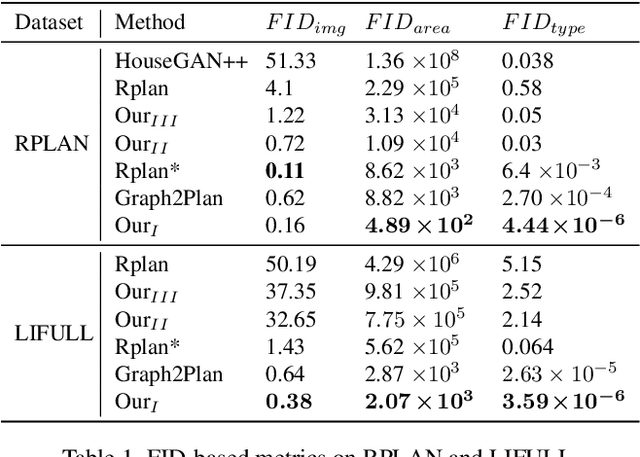

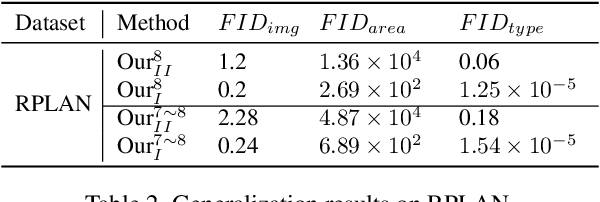
Abstract:Layout design is ubiquitous in many applications, e.g. architecture/urban planning, etc, which involves a lengthy iterative design process. Recently, deep learning has been leveraged to automatically generate layouts via image generation, showing a huge potential to free designers from laborious routines. While automatic generation can greatly boost productivity, designer input is undoubtedly crucial. An ideal AI-aided design tool should automate repetitive routines, and meanwhile accept human guidance and provide smart/proactive suggestions. However, the capability of involving humans into the loop has been largely ignored in existing methods which are mostly end-to-end approaches. To this end, we propose a new human-in-the-loop generative model, iPLAN, which is capable of automatically generating layouts, but also interacting with designers throughout the whole procedure, enabling humans and AI to co-evolve a sketchy idea gradually into the final design. iPLAN is evaluated on diverse datasets and compared with existing methods. The results show that iPLAN has high fidelity in producing similar layouts to those from human designers, great flexibility in accepting designer inputs and providing design suggestions accordingly, and strong generalizability when facing unseen design tasks and limited training data.
Understanding the Robustness of Skeleton-based Action Recognition under Adversarial Attack
Mar 18, 2021
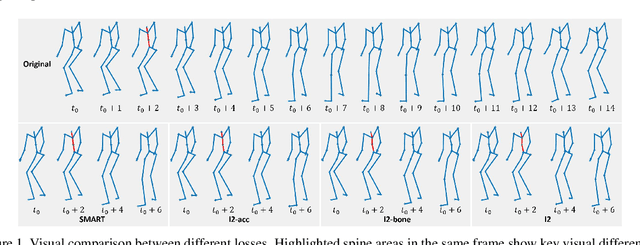
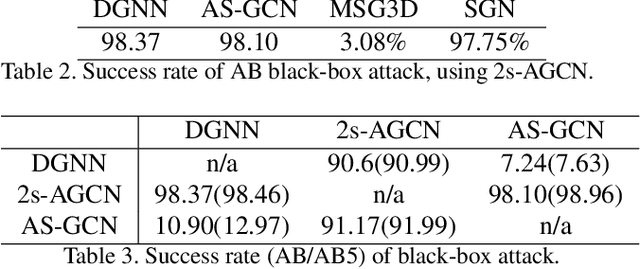

Abstract:Action recognition has been heavily employed in many applications such as autonomous vehicles, surveillance, etc, where its robustness is a primary concern. In this paper, we examine the robustness of state-of-the-art action recognizers against adversarial attack, which has been rarely investigated so far. To this end, we propose a new method to attack action recognizers that rely on 3D skeletal motion. Our method involves an innovative perceptual loss that ensures the imperceptibility of the attack. Empirical studies demonstrate that our method is effective in both white-box and black-box scenarios. Its generalizability is evidenced on a variety of action recognizers and datasets. Its versatility is shown in different attacking strategies. Its deceitfulness is proven in extensive perceptual studies. Our method shows that adversarial attack on 3D skeletal motions, one type of time-series data, is significantly different from traditional adversarial attack problems. Its success raises serious concern on the robustness of action recognizers and provides insights on potential improvements.
Informative Scene Decomposition for Crowd Analysis, Comparison and Simulation Guidance
Apr 29, 2020



Abstract:Crowd simulation is a central topic in several fields including graphics. To achieve high-fidelity simulations, data has been increasingly relied upon for analysis and simulation guidance. However, the information in real-world data is often noisy, mixed and unstructured, making it difficult for effective analysis, therefore has not been fully utilized. With the fast-growing volume of crowd data, such a bottleneck needs to be addressed. In this paper, we propose a new framework which comprehensively tackles this problem. It centers at an unsupervised method for analysis. The method takes as input raw and noisy data with highly mixed multi-dimensional (space, time and dynamics) information, and automatically structure it by learning the correlations among these dimensions. The dimensions together with their correlations fully describe the scene semantics which consists of recurring activity patterns in a scene, manifested as space flows with temporal and dynamics profiles. The effectiveness and robustness of the analysis have been tested on datasets with great variations in volume, duration, environment and crowd dynamics. Based on the analysis, new methods for data visualization, simulation evaluation and simulation guidance are also proposed. Together, our framework establishes a highly automated pipeline from raw data to crowd analysis, comparison and simulation guidance. Extensive experiments and evaluations have been conducted to show the flexibility, versatility and intuitiveness of our framework.
SMART: Skeletal Motion Action Recognition aTtack
Nov 21, 2019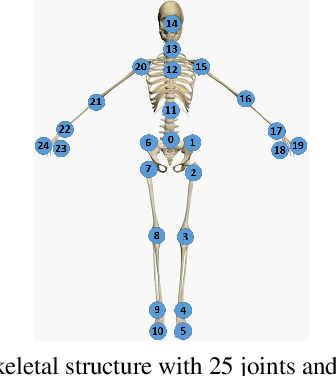
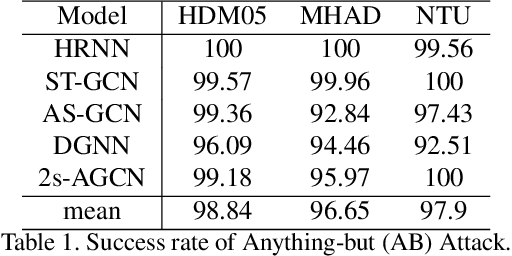
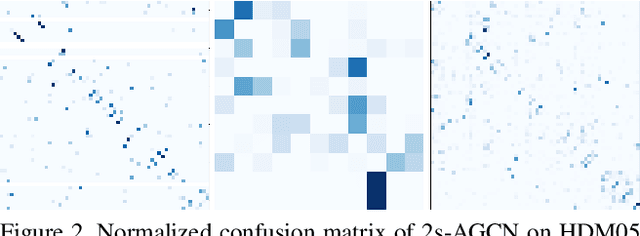
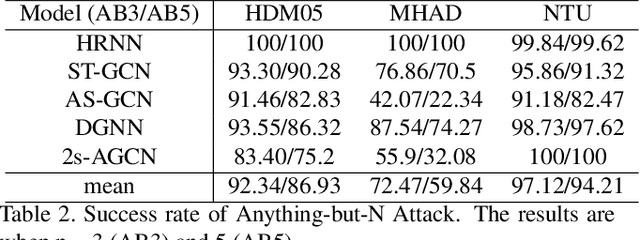
Abstract:Adversarial attack has inspired great interest in computer vision, by showing that classification-based solutions are prone to imperceptible attack in many tasks. In this paper, we propose a method, SMART, to attack action recognizers which rely on 3D skeletal motions. Our method involves an innovative perceptual loss which ensures the imperceptibility of the attack. Empirical studies demonstrate that SMART is effective in both white-box and black-box scenarios. Its generalizability is evidenced on a variety of action recognizers and datasets. Its versatility is shown in different attacking strategies. Its deceitfulness is proven in extensive perceptual studies. Finally, SMART shows that adversarial attack on 3D skeletal motion, one type of time-series data, is significantly different from traditional adversarial attack problems.
 Add to Chrome
Add to Chrome Add to Firefox
Add to Firefox Add to Edge
Add to Edge